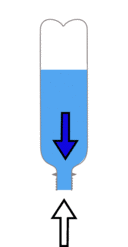Hurricanes in a Lemonade Bottle
Derek - Hello and welcome once again to the Naked Scientists' laboratory. Today we have an unbelievably easy and very cool experiment that you can do at home. With me to describe exactly what we'll be doing is Professor Herbert Huppert from Cambridge University. How are you doing?
Herbert - How are you?
Derek - I'm fine and very much looking forward to what we've got set up. So what is it that we're going to be doing today?
Herbert - We're going to do a simple experiment that's going to have some quite surprising results. We're going to make a tornado in a kitchen in a simple lemonade bottle.
Derek - And we'll be hearing exactly how to do that in a moment. With us as well is a helper. Can you tell us your name and age please?
Henry - I'm Henry and I'm twelve.
Derek - Thanks very much for coming in and helping us do this experiment. What is it that you like about science?
Henry - I like science because it's related to everything. The things we do know are magnificent but the things we don't know are absolutely fascinating.
Derek - Wow. Fantastic answers and of course we will be relating this experiment to some very real things later on as well. What you need is: a two litre lemonade bottle, and really that is it. You need to do this in your kitchen and fill that bottle up with water. Then you need to do some things to it, which Herbert will now describe. What do people have to do Herbert?
Herbert - There are really two parts to this experiment and we're going to compare the results. The first part consists of filling up the bottle with water right to the top and then just turning it upside down and watching how the water escapes, how quickly that happens and what limits the escape of the water.
Derek - People might already know what's going to happen there, but we're also going to ask them to do something else. So what's that?
Herbert - What we're going to do in the second experiment is rather than just letting the water pour out of the bottle, we're going to give the water and the bottle some swirl to start with. We're going to turn it round rapidly in a rotary motion so that as well as the water pouring out of the bottle, it's also going round and that'll make a difference.
Derek - So just to reiterate that, you've got to get the bottle full of water and then as soon as you turn it upside down to pour the water out, you've got to move it round in big swift circles. We don't mean just twisting the bottle. We actually mean moving the whole bottle round in big continuous circles. It's important to actually swirl it for a few rotations trying to get the whirlpool effect and then stop swirling it and see what happens. And that's all there is to the experiment. Henry, what do you think is going to happen?
Henry - It'll create a whirlpool?
Derek - Well what we want to know really is what's going to happen to the water pouring out? How's it going to be different?
Henry - I don't know.
Derek - Well we'll be finding out! Find out at home yourselves and we'll come back and find out the answer later.
LATER…. Derek - Hi again. Yes welcome back to the Naked Scientists' laboratory where we have been poised ready to do some pouring of water from lemonade bottles. With me is Herbert Huppert who'll be giving us an explanation of what's going on, and of course Henry, who's going to be doing it. Herbert, would you care to instruct Henry on what he's got to do first?
Herbert - In the first experiment, you've got to take the full bottle of water and you tip it upside down into the sink and watch what happens.
Henry - Ok, the water's glugging as the air rushes in as the water pours out.
Derek - And how well is the water rushing out?
Henry - Not particularly well.
Derek - It's just about coming to the end now and looks to me as though it's taken about 20 seconds, so not very quick. But we've got another condition to try now.
Herbert - Yes, now fill up the bottle again with water. We're going to start this experiment with exactly the same amount of water and the same sort of bottle so we can make comparisons between two different styles of experiment.
Derek - And so the second condition of pouring out the bottle is what?
Herbert - Henry has to turn the bottle upside down into the sink but this time rotate it swiftly around in circles so that you give it some rotary motion as it comes out.
Henry - Oh cool! It created a whirlpool when I stopped and it just poured all the way out so it was sort of circular. There was water at the sides but there was no water in the centre.
Derek - And how well do you think it came out this time?
Henry - Very well.
Derek - Yes, and that took about 10 seconds, which is at least twice as quick as doing it without swirling. So Herbert, what does all this mean and why, firstly, is this happening?
Herbert - An important point is not only does the water have to come out of the bottle, but the air has to come back in. There's a competition between the water flowing out and the air flowing back in, and that competition normally causes the glug glug glugging that we hear so much. In the second experiment where we rotated it round quite quickly, you made a whirlpool like a tornado and that spun the relatively heavy water out to the sides. This allowed the air to come in through the central core. Then there was no fight between the air and the water. The air moved in quite nicely at the centre and it can be two or three times or even more quicker to empty a bottle that way.
Derek - So where do we see this? Have we really created a tornado in the lab?
Herbert - Yes we have created a tornado. The most important thing that Henry did was that he added rotation. That made for the central vortex that he got such a shock about. There are lots of situations especially in the atmosphere where the rotation plays an important role. The rotation is provided by the Earth's rotation because it rotates on its axis once every day. The best example I can give you is Hurricane Katrina. If the Earth was not rotating, Hurricane Katrina and all these hurricanes would never happen.
Derek - And also we saw that what we created was sucking up air. Is this effect something we see in hurricanes and tornadoes as well?
Herbert - Yes that's the important aspect of hurricanes and how they can continue to exist. They suck up warm water from the ocean and they vaporise it. That's where they get their energy.
Derek - So Henry, does that all make sense to you?
Henry - Yes it does.
Derek - And how did you like our experiment?
Henry - It was very interesting.
Derek - And will you be going home and emptying bottles to your heart's delight?
Henry - Yep.
Derek - Well that's wonderful. We have another convert here, that's great. Well that's all from the Naked Scientists' laboratory and we hope you can join us next time.
Ingredients
A lemonade bottle
Some water
A sink
Instructions
1- Fill the lemonade bottle with water.
2- Turn it upside down empty the bottle - what happens?
3- Fill the bottle again
4- Empty the bottle again, this time swirling it - what happens?
Result
You should find that if you just empty the bottle it empties quite slowly but if you swirl it, the water creates a whirlpool and empties much quicker.
Explanation
For the water to get out of the lemonade bottle something has to take its place, and the most convenient thing to do so is air. So the air is trying to move up whilst the water moves down. There is obviously a conflict here, ther normal way is for some water to fall out then a bubble moves up through the neck, allowing more water to fall out. The water comes out in big lumps, which is actually quite a slow process, because it has to keep speeding up and slowing down.


 However if you give the water a bit of a swirl as you empty it, something entirely different happens. Although the water is only spinning quite slowly to begin with, as it moves inwards towards the neck it speeds up to the point where it is thrown out to the sides of the bottle by centrifugal force* so strongly it forms a hollow tube with an airspace in the centre. This allows the air to get into the bottle much more quickly than as bubbles because it is a continuous process, so even though the water is flowing out through less of the neck it will flow faster, and the bottle will empty more quickly.
However if you give the water a bit of a swirl as you empty it, something entirely different happens. Although the water is only spinning quite slowly to begin with, as it moves inwards towards the neck it speeds up to the point where it is thrown out to the sides of the bottle by centrifugal force* so strongly it forms a hollow tube with an airspace in the centre. This allows the air to get into the bottle much more quickly than as bubbles because it is a continuous process, so even though the water is flowing out through less of the neck it will flow faster, and the bottle will empty more quickly.
Why does the the water spin faster in the neck?
There are two effects which contribute to this. Even if the water was going at the same speed at the neck of the bottle as the outside, because the circle it has to travel in is much smaller it would take far less time for it to do a rotation, so it would be spinning faster.
Also when the water moves into the centre it has to fight against centrifugal force this uses energy, and this actually goes into spinning the water even faster.
What has this got to do with hurricanes?
A hurricane starts to form over some particularly warm water, this heats up the air making it lighter and the water evaporates producing water vapour which is also lighter than air. This warm wet air begins to rise sucking cooler air in at the sides. Because the world is spinning the air being sucked in is spinning slowly to start with, as it is pulled in it gets faster and faster (just like the water in your bottle). If the hurricane is large enough this can produce winds of up to 225kph (140mph), quite capapble of hurling trees, cars and houses all over the place.
* Centrifugal force is a pseudo (pretend) force that can be useful in thinking about rotating objects - it is the force that is applied to something else (a string, the ground etc) that is needed to keep an object (which would naturally go in a straight line) travelling in a circle. Although it is not real it is often a useful way of thinking about things.
- Previous Decoding a computer-generated voice
- Next Cornflour and Gravy










Comments
Add a comment